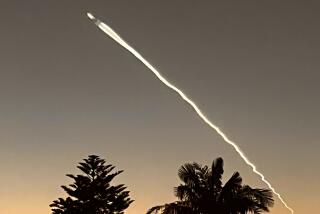Magellan Probe Maneuvers Into Orbit of Venus
- Share via
After its 15-month journey from Earth, the Magellan spacecraft, a planetary probe cobbled together from leftover pieces of other projects, slipped into a perfect orbit around Venus Friday morning, providing NASA with an emotional high in its long summer of discontent.
The maneuver required the spacecraft to fire its solid-rocket motor while it was behind Venus and out of touch with human controllers at Jet Propulsion Laboratory. Project scientists spent a tense 21 minutes until the spacecraft emerged again at 10:06 a.m., signaling a successful firing and precipitating high fives, bearhugs and prolonged clapping. Had the solid rocket not fired, the craft would have sailed past the planet at 25,000 miles per hour and been lost forever.
Later this month, Magellan will start radar mapping the cloud-shrouded surface of our sister planet, painting a portrait more detailed than what is available even for much of the Earth, which is shielded from such mapping by its oceans. At its low point, the spacecraft will sweep within 186 miles of the planet.
The flight to the hot, dry planet and insertion into orbit went so smoothly, JPL researchers said, that Magellan was left with a large excess of fuel for its maneuvering rockets, enough to keep it in operation for 30 years, decades longer than had been projected.
Magellan is the first of several planetary probes already launched or in preparation that will give the United States operating observatories around other objects in the solar system--including Jupiter, Mars, Saturn, asteroids and comets--well into the next century. “We are back in the planetary exploration business,” said JPL’s Steve Wall.
In a press conference after the successful rocket firing, NASA associate administrator Lennard A. Fisk shrugged off questions about NASA’s short-term grounding of its shuttle fleet because of hydrogen leaks. Instead he focused on the successful Venus flyby of Galileo earlier this year, the launches of the Cosmic Background Explorer observatory last November and the Gamma-Ray Observatory in June and the upcoming launch of Ulysses into a solar orbit.
Magellan is not the first spacecraft to reach Venus. Soviet and American probes have preceded it, and two of the Soviet probes even landed on the surface, transmitting pictures of a parched, cracked landscape. But those pictures only covered the area immediately surrounding the craft’s landing site.
The Soviets have also used cloud-piercing radar to map the upper quarter of the planet, and U.S. scientists have employed the massive Arecibo radio observatory to map the entire planet, but only very crudely. In both cases, the resolution was sufficient only to pick out objects the size of 10 football fields, just enough “to whet our appetites,” said JPL’s Bob MacMillan.
Magellan, in contrast, will be able to image objects the size of a single football field, providing unprecedented clarity.
Researchers hope that by observing Venus in great detail, they will be able to learn about not only its past but Earth’s as well. Venus is very nearly Earth’s twin in size, but its surface temperature is 900 degrees Fahrenheit and its atmospheric pressure is 90 times that of Earth, indicating that two planets took different paths in a very early stage of planetary evolution.
The sweltering temperature of Venus is caused by the high concentration of carbon dioxide in its atmosphere, which permits the sun’s heat to pass through and warm the planet but prevents heat from escaping back into space. Researchers are predicting a similar, albeit less disastrous, “greenhouse effect” on Earth because of continued release of carbon dioxide into the atmosphere.
“From looking at places like Venus, we can . . . know more about what might happen on Earth,” said Gentry Lee of JPL.
But geologists are especially interested in studying the surface of Venus, which “is completely unlike anything seen on Earth or Mars,” according to JPL’s Stephen Saunders, Magellan’s chief scientist. Because so much of the Earth’s crust is obscured by oceans, geologists have a hard time interpreting many of its features. The study of Venus should give insight into Earth’s crustal mechanics.
“We need to know a lot more about that planet to understand our own,” Saunders said.
But researchers will have to wait a little longer. Spacecraft controllers will spend the next three weeks checking Magellan’s systems and flexing its radar unit. The actual mapping will begin Aug. 29 if no adjustment to its orbit is necessary, as now seems likely, or Sept. 1 if adjustment is required.
Magellan will spend about a third of each 3.2-hour orbit mapping a narrow swath of Venus about 16 miles wide. During the remainder of the orbit, the data will be radioed to Earth. The spacecraft will require one Venus day--243 Earth days--to map about 80% of its surface, all but the south pole.
During that phase, Magellan will radio back to Earth more data than all the previous planetary probes combined.
Following this primary mission, the spacecraft will enter an extended mission in which it will map the remaining 20% of the planet and go back over interesting parts of the surface to provide stereoscopic images.
The satellite and its operation for the next year will cost NASA $551 million. Counting the cost of its launch by the shuttle Atlantis, the total cost of the mission is $744 million. An additional $169 million will be necessary to keep it in operation through 1995.






